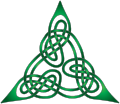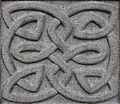Knot pattern
Knot patterns are typical of the performing arts of the early and high Middle Ages , particularly in Italy and the British Isles . They are often referred to as a Celtic knot or Celtic pattern ( English celtic design or celtic patterns ). Important examples are the Book of Durrow , the Lindisfarne Gospel, and the Book of Kells .
Derivation
John Romilly Allen (1847–1907) derived the knot patterns in the British Isles from Italian models of the 5th and 6th centuries. Lethaby saw the origin of the Italian and Anglo-Saxon knot patterns in the patterns of Coptic textiles that he believed brought Coptic Christians to Britain. He refers to knot patterns on early Arab silk textiles, which he also traces back to Coptic models. According to Jacques Guilmain, important ideas for the Book of Durrow may have come from pagan, Celtic, Germanic and Coptic art.
- Knot pattern in evangelists
history
With the onset of Christianity, cross-slabs ( Aberlemno ), gravestones, high crosses , bowls, pieces of jewelry, saddles, sword handles and scabbards as well as plates are decorated with knot patterns in Ireland . The patterns are also used in manuscripts, the best known being the Irish Book of Kells.
Theses on the creation
According to Nylén , the Gotlandic picture stones adorned with borders made of knot patterns are a fragmentary part of an early medieval world of forms, which was mainly depicted on wood and textile. Hierograms - amulets and talismans - would have played an important role in the prehistoric world of ideas. From the borders of the picture stones one can see that the larger part has been shaped according to a certain system with purposeful intention. Textile art probably served as a model for the design of the braids. If you color the pattern strands differently, you can more easily follow the play of lines and the imaginative interweaving. Tapestries like those of Oseberg and Härjedalen could also have served as models. Many characters on the stones have an “infinity character”, in which a line or a band never ends but returns to itself. There are knots and wheels, stars and crosses, accordingly symbols, each of which had a well-known meaning, as symbols for powers and gods - good and bad, depending on the intention and context in the imagery of the stones. There are also relief rune stones with knot patterns , especially on Gotland and Öland ( relief rune stones in Löts kyrka ).
- Knot pattern on picture stones & relief stones
Picture stone with loop square from Stora Havor
template
Despite some changes over time and regional characteristics, there are basic patterns and all node patterns follow strict geometric rules. The basic patterns are:
- Spirals
- Wickerwork pattern "( endless ) knots ", ( English celtic knots )
- Maze pattern
- Animal pattern
The ornate letters, the tree of life and patterns with mythical creatures , which appeared from the middle of the 5th century onwards, are based on these four basic patterns . The patterns are combined with one another more or less at will.
Celtic knot
Under Celtic knot is understood Bandflechtmuster that meet the following requirements:
- Braided character: The band always runs over the top and then back through the bottom.
- The course of the belt is endless: the belt closes. Sometimes figurative representations can be found at the corner points of the bands.
Celtic knot - 3D computer graphics
Celtic knot with two ribbons (decorative element on grave stele, Glasgow Necropolis )
Maze pattern
In contrast to the knot or wickerwork patterns, labyrinth patterns always form a continuous path without crossings.
Knot and wickerwork patterns
The Nordic variant of the knot style is the Germanic animal style with its different styles. However, it is used more sparingly and often only as border decoration.
See also
- Khachkar
- Endless knot
- Braided tape
- Fish bladder (ornament)
- Germanic animal style
- Gauts wickerwork
- Celtic cross
- Knot garden
- ornament
- Platting
- Croatian braid pattern
literature
- George Bain: Celtic Art. The Methods of Construction. Dover Publications, New York 1973, ISBN 0-486-22923-8 .
- Courtney Davis: Celtic Designs and Motifs. Constable et al., London et al. 1991, ISBN 0-486-26718-0 .
- Erik Nylén , Jan Peder Lamm: Picture stones on Gotland. Wachholtz, Neumünster 1981, ISBN 3-529-01823-6 (2nd expanded and completed edition, ibid 1991).
Individual evidence
- ^ J. Romilly Allen: Celtic art in pagan and Christian times (= The Antiquary's books ). Methuen, London 1904 (Reprint. Bracken Books, London 1994, ISBN 1-85891-075-7 ).
- ^ William R. Lethaby: The Origin of Knotted Ornamentation. In: The Burlington Magazine for Connoisseurs. Vol. 10 = No. 46, January 1907, ISSN 0951-0788 , p. 256.
- ↑ Jacques Guilmain: The Geometry of the Cross-Carpet Pages in the Lindisfarne Gospels , in: Speculum 62.1 (1987) 21-52.
- ↑ Erik Nylén, Jan Peder Lamm: picture stones on Gotland. 2nd expanded and completed edition. Wachholtz, Neumünster 1991, p. 64.
Web links
- http://www.thinkythings.org/knotwork/jra-knots.html The eight basic patterns of Celtic knots
- http://www.thinkythings.org/knotwork/celthome.html The Celts - construction methods, origins, meaning, Celtic crosses (Drew Ivan)
- http://isotropic.org/uw/knot/howto/ - Celtic Knot Thingy - A program for creating knots.
- http://www.entrelacs.net/ - Another method of creating knot patterns yourself (F, E, D)














